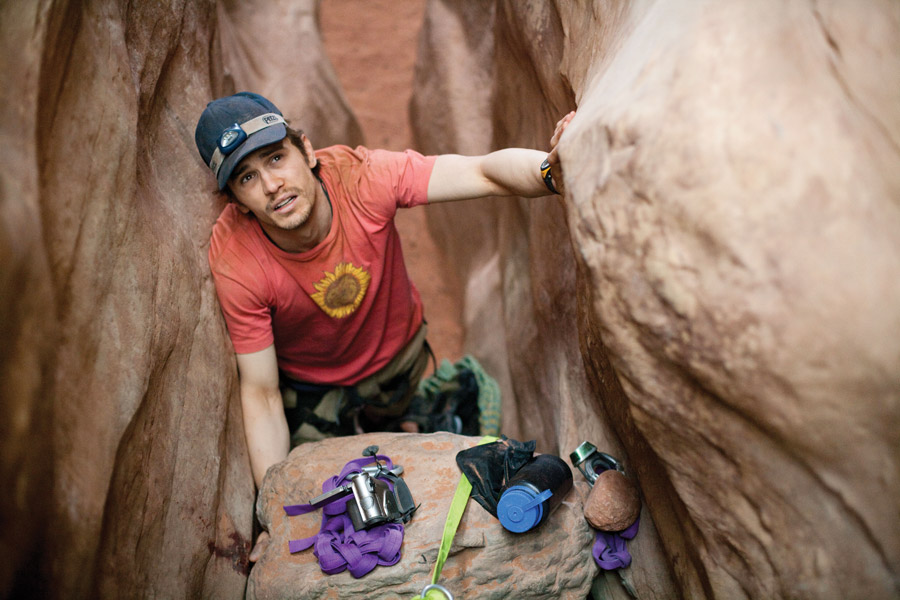

“127 Hours” is more than just a film about a guy who cuts off his arm; it’s more than just another Oscar vehicle for a heart throb – yes, ladies, I’m talking about James Franco. “127 Hours” is, for all intents and purposes, a film about triumph, survival and overcoming the impossible by realizing life is most enjoyable when shared with others.
Co-written and directed by Academy Award winner Danny Boyle, “127 hours” follows the true story of mountain climber Aron Ralston, as he begins a journey that will change his life forever, both physically and mentally.
From the moment we first encounter him, Aron (Franco) is introduced as a risk-taker who embraces loneliness. Instead of taking the time to return his mother’s unanswered phone calls, he leaves his home in a rush to challenge himself among the canyons of Utah.
On his trek, Aron stumbles upon two lost hikers, Kristi (Kate Mara) and Megan (Amber Tamblyn). And even though the three share a fun few hours exploring the beautiful scenery, he leaves them and returns to his solo journey. When they invite him to a party, you can see in his expression that even though he accepts the proposal, he will not be joining the festivities.
Instead, Aron is constantly giddy for a new experience, a new adventure alone. As he mountain bikes through the rough, desert terrain and face plants into the ground, he manages to smile and snap a photograph of his embarrassing and painful failure. That’s the kind of person Aron is. He’s not afraid to fall down because he knows he can get back up all by himself. That is, until he meets the boulder.
A master at his craft, Boyle spends the next three quarters of the film alone with Franco. But what keeps the narrative moving, aside from the occasional flashback, is Boyle’s incredible creativity and ingenuity in thrusting the audience deeper into the main character’s struggle to survive while stuck between a rock and a hard place.
Often the film will split into three separate pieces, each showing a different viewpoint of a single action. When Aron jumps into a hidden riverbed beneath a canyon with Kristi and Megan, the audience free falls into the water with each dive. When Aron sips from his slowly dwindling pouch of water, the audience is sucked through the straw into his mouth. And when Aron stabs his arm with his dull pocket knife in desperation, the audience sees the knife stop short on his bone from a perspective within his arm.
Boyle is constantly reinventing himself and figuring out new ways to portray layered details. He is the very definition of a maverick filmmaker, and utilizes a rare ability to take small budgets and make massive movies that feel both raw and expensive. With dozens of tricks under his belt, Boyle has proven himself to be capable of providing audiences with incredibly personal films like “127 Hours” and “Trainspotting,” as well as epic science fiction thrillers like “Sunshine” and “28 Days Later.” And let’s not forget the film that won him an Oscar, “Slumdog Millionaire.”
Franco’s portrayal of Aron is honest and endearing. Each burst of anger, sorrow, laughter and insanity feel real and Franco carries the entire film on his back with ease. As each day passes within the predicament, Franco reenacts and reinvents video messages recorded during Aron’s real life struggle and speaks directly into the camera without breaking the fourth wall.
With each video message, Aron realizes the mistakes he has made within his life. Loneliness was his curse, but in order to survive and reemerge, he must overcome his past. He becomes honest with himself about how he has treated those around him. He reflects on lost relationships with members of his family, and looks back at past loves he mistakenly mistreated and neglected. The rock holding his arm in place, trapping him to the point of certain death, is more than just a boulder. It’s a symbol that represents everything that has held him back throughout his life.
By the time the soon-to-be iconic scene comes to fruition and Aron must sever his own arm, you are no longer anticipating it; you’re begging for it. And when all is said and done, “127 Hours” delivers on every possible front, with a message that will, without question, last a lifetime.
